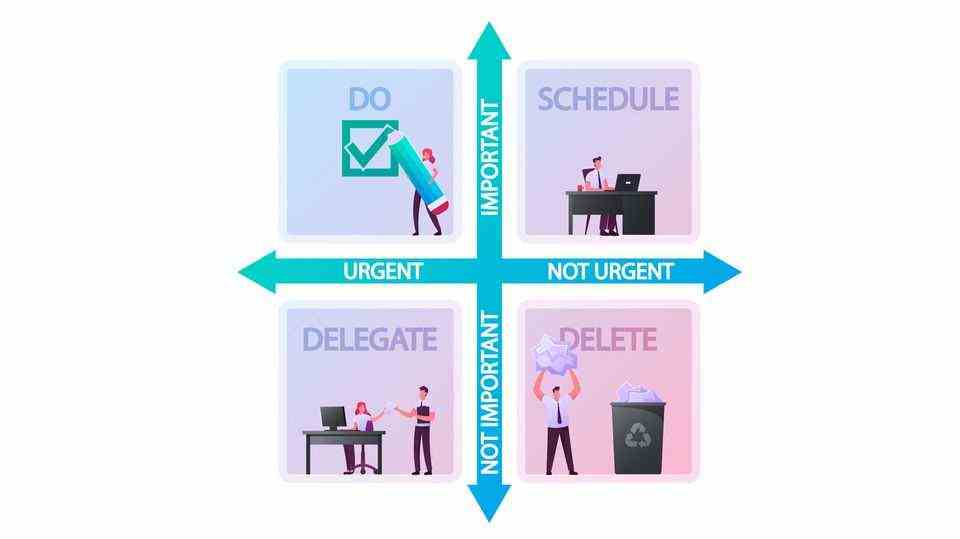The Eisenhower technology helps you to optimize your personal time management at work and in everyday life and thus to effectively reduce everyday stress. An important skill in today’s fast paced world.
Tasks, projects or obligations can add up and exert enormous pressure faster than expected. With all the to-dos you literally lose track, feel lost and, above all, stressed. It can happen that you get bogged down with too many simultaneous expenses and let yourself be absorbed by unimportant, less urgent to-dos. At this point, a simple to-do list is often no longer enough to get an overview.
In order to prevent the workload and stress from overwhelming us, you inevitably have to learn to better prioritize and schedule tasks. The Eisenhower technique is an effective method to support you in your day-to-day planning. It differentiates between important, urgent tasks and unimportant, non-urgent tasks. It is crucial that important tasks are completed immediately and unimportant tasks are either delegated or eliminated.
Dangers of permanent stress
Everyone has it, nobody wants it – stress, which is mainly caused by constant time pressure. In addition, there is often a good load of pressure to perform and perfectionism – after all, there is the expectation of completing all tasks with an error rate of zero. In everyday life – under the double burden of professional and private life, the tendency to multitasking and the constant availability through digitization – we are less and less able to relax, it is difficult to switch off and we are usually permanently energized.
Not infrequently, this non-stop rushing can have immense consequences for health and psyche and end in depression or burnout. Chronic stress is also noticeable through physical symptoms and is caused by the increased amount of stress hormones that affect various metabolic processes in the body. Examples include indigestion, difficulty concentrating, headaches and back pain, and decreased libido.
Last but not least, chronic stress weakens the immune system because stress hormones block the immune cells. A certain amount of stress cannot be avoided and can even provide drive and motivation. However, it is important to find the right balance between work and relaxation and to take breaks.
Planning Like a President – Origin of the Method
The Eisenhower Principle is a time management method, the name of which goes back to the former US President Dwight D. Eisenhower. Allegedly, this is said to have mixed the classic time management with a mailbox exercise and thus developed the Eisenhower principle. However, there is no solid evidence that Eisenhower himself practiced or taught the method. However, there is a reference in a speech by Eisenhower from 1954: “I have two kinds of problems, the urgent and the important. The urgent are not important, and the important are never urgent.” – Translated, this well-known quote means nothing else than “I have two kinds of problems, the urgent and the important. The urgent ones are not important and the important ones are never urgent”, and describes the method in one sentence.
The application of the Eisenhower technique …
… is simpler than you think and is based on one principle: what is important is separated from what is unimportant, the important things are done before the unimportant. As simple as it may sound at first, setting priorities and unmasking unimportant time wasters can sometimes be a major challenge. In addition to the urgency and relevance of the tasks, the time available for a task also plays an important role.
First, you collect all of the pending tasks and list them in order to then assess them according to the following two criteria in the next step:
1. Urgency
- How quickly does a matter have to be resolved or dealt with?
- Is there a deadline?
- What if you do the job later?
2. Importance:
- How important or necessary is a matter?
- What benefit / advantage do I get from it?
- What are the consequences if you don’t do the job?
- Can someone do the job?
By combining the two possible criteria, you can then assign each task to a category. This step is often shown in the form of a matrix in order to better visualize the resulting distribution of tasks.
1. Important and urgent – do it immediately
The first quadrant contains the important and urgent tasks. They have high priority and are taken care of immediately without being planned or delegated.
2. Important, but not urgent – plan
Important tasks that do not have to be done urgently can be planned. They can be done at a later time. However, they need to be planned well in advance so that they do not become urgent.
3. Urgent but not important – If possible: delegate
Often tasks are not immediately important, but urgent. They can be delegated, that is, given to someone. If that is not possible, you should cancel the task or do it spontaneously if time is available.
4. Neither important nor urgent – eliminate
These tasks are currently not relevant and should be removed directly from your to-do list. This gives you enough time for important and urgent tasks.

The Eisenhower matrix evaluates tasks according to the criteria of urgency (Urgent) and importance (Important).
© invincible_bulldog / Getty Images
When assessing the tasks, the principle that important tasks are always directly related to your personally defined goal is important.
Working with Eisenhower technology may seem banal to you at first, but the principle may also seem self-evident. Nevertheless, the regular visualization and assessment of the scope of your work can help to gain an overview of the various areas of your life. Usually, a specific processing plan helps to reduce stress – and to recognize that everything is half as bad as initially feared. Last but not least, you can use technology to identify habits as pure time wasters and stressors and thus banish them from your life.


